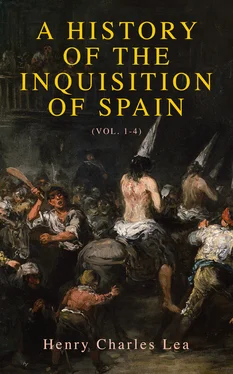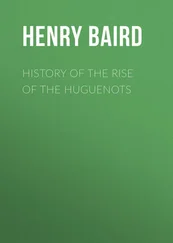Yet I have been led to the conviction that her share in the administration of her kingdom has been exaggerated. The chroniclers of the period were for the most part Castilians who would naturally seek to subordinate the action of the Aragonese intruder, and subsequent writers, in their eagerness to magnify the reputation of Isabella, have followed the example. In the copious royal correspondence with the officials of the Inquisition the name of Isabella rarely appears. To those in Castile as in Aragon Ferdinand mostly writes in the first person singular, without even using the pluralis majestatis ; the receiver of confiscations is mi receptor , the royal treasury is mi camera e fisco ; the Council of the Inquisition is mi consejo . In spite of the agreement of 1474, the signature Yo la Reina rarely appears alongside of Yo el Rey , and still rarer are Ferdinand’s allusions to la Serenissima Reina, mi muy cara e muy amada muger , while in the occasional letters issued by Isabella during her husband’s absence, she is careful to adduce his authority as that of el Rey mi señor . [73]It is scarce likely that this preponderance of Ferdinand was confined to directing the affairs of the Holy Office.
There has been a tendency of late to regard the Inquisition as a political engine for the conversion of Spain from a medieval feudal monarchy to one of the modern absolute type, but this is an error. The change effected by Ferdinand and Isabella and confirmed by their grandson Charles V was almost wholly wrought, as it had been two centuries earlier in France, by the extension and enforcement of the royal jurisdiction, superseding that of the feudatories. [74]In Castile the latter had virtually ceased to be an instrument of good during the long period of turbulence which preceded the accession of Isabella; something evidently was needed to fill the gap; the zealous and efficient administration of justice, which I have described, not only restored order to the community but went far to exalt the royal power, and, while it abased the nobles, it reconciled the people to possible usurpations which were so beneficent. In the consolidation and maintenance of this no agency was so effective as the institution known as the Santa Hermandad .
LA SANTA HERMANDAD
Hermandades—brotherhoods or associations for the maintenance of public peace and private rights—were no new thing. In the troubles of 1282, caused by the rebellion of Sancho IV against his father, the first idea of his supporters seems to have been the formation of such organizations. [75]In these associations, however, the police functions were subordinated to the political object of supporting the pretensions of Sancho IV and, recognizing their danger, he dissolved them as soon as he felt the throne assured to him. After his death, his widow the regent Doña María de Molina, organized them anew for the protection of her child, Fernando IV, and again in 1315, when she was a second time regent in the minority of her grandson, Alfonso XI. [76]
The idea was a fruitful one and speedily came to be recognized as a potent instrumentality in the struggle with local disorder and violence. Perhaps the earliest Hermandad of a purely police character, similar to the later ones, was that entered into in 1302 between Toledo, Talavera and Villareal to repress the robberies and murders committed by the Golfines in the district of Xara. Fernando IV not only confirmed the association but ordered the inhabitants to render it due assistance, and subsequent royal letters of the same purport were issued in 1303, 1309, 1312 and 1315. [77]In 1386 Juan I framed a general law providing for the organization and functions of Hermandades, but if any were formed under it at the time they have left no traces of their activity. In 1418 this law was adopted as the constitution of one which organized itself in Santiago, but this accomplished little and, in 1421, the guilds and confraternities of the city united in another for mutual support and succor. [78]There was, in fact, at this time, at least nominally, a general Hermandad, probably organized under the statute of Juan I and possessing written charters and privileges and customs and revenues, with full jurisdiction to try and condemn offenders. It commanded little respect, however, for it complained, in 1418, to Juan II of interference with its revenues and work, in response to which Juan vigorously prohibited all royal and local judges and officials from impeding the Hermandades in any manner. The continuity, nominal at least, of this with subsequent organizations is shown by the confirmation of this utterance by Juan II in 1423, by Ferdinand and Isabella in 1485, by Juana la Loca in 1512 and 1518, by Philip II in 1561, by Philip III in 1601 and by Philip IV in 1621. [79]In the increasing disorder of the times, however, it was impossible, at that period, to maintain the efficiency of the body. In 1443 an attempt was made to reconstruct it, but as soon as it endeavored to repress the lawless nobles and laid siege to Pedro López de Ayala in Salvatierra its forces were cut to pieces and dispersed by Pedro Fernández de Velasco. [80]Some twenty years later, in 1465, when the disorders under Henry IV were culminating, another effort was made. The suffering people organized and taxed themselves to raise a force of 1800 horsemen to render the roads safe, and they endeavored to bring the number up to 3000. It was a popular movement against the nobles and the king hailed it as the work of God who was lifting up the humble against the great. He empowered them to administer justice without appeal except to himself, he told them that they had well earned the name of Santa Hermandad and he urged them earnestly to go forward in the good work. The attempt had considerable success for a time, but it soon languished and was dissolved for lack of the means required to carry it on. [81]Again, in 1473, there was another endeavor to form a Hermandad, but the anarchical forces were too dominant for its successful organization. [82]
LA SANTA HERMANDAD
As soon as the victory of Toro, in March, 1476, gave promise of settled government, the idea of reviving the Hermandades occurred to Alfonso de Quintanilla, Contador Mayor, or Chief Auditor, of Ferdinand and Isabella. With their approval he broached the subject to leading citizens of the principal towns in Leon and Old Castile; deputies were sent to meet at Dueñas and the project was debated. So many obstacles presented themselves that it would have been abandoned but for an eloquent argument by Quintanilla. His plan was adopted, but so fearful were the deputies that the taxes necessary for its maintenance might become permanent that they limited its duration to three years. Under the impulse of the sovereigns it rapidly took shape and was organized with the Duke of Villahermosa, natural brother of Ferdinand, at its head. [83]No time was lost in extending it throughout the kingdoms, in spite of resistance on the part of those who regarded with well-founded apprehension not only its efficiency as a means of coercing malefactors but as a dangerous development of the royal power. Seville, for instance, recalcitrated and only yielded to a peremptory command from Isabella in June, 1477. [84]One of the reasons assigned, in 1507, by Ferdinand for assenting to the demoralizing arrangement under which the Archbishop of Compostella resigned his see in favor of his natural son, was that he had received the royal judges and the Hermandad throughout his province, in opposition to the will of the nobles and gentry. [85]When, in 1479, Alonso Carrillo and the Marquis of Villena made a final attempt to urge the King of Portugal to another invasion of Castile, one of the arguments advanced was the hatred entertained for Ferdinand and Isabella in consequence of the taxes levied to support the three thousand horsemen of the Hermandad. [86]In some provinces the resistance was obstinate. In 1479 we find Isabella writing to the authorities of Biscay, expressing surprise at the neglect of the royal orders and threatening condign punishment for further delay, notwithstanding which repeated commands were requisite, and it was not till 1488 that the stubborn Biscayans submitted, while soon afterward complaints came from Guipuzcoa that the local courts neutralized it by admitting appeals from its sentences. [87]It was in the same year that Ferdinand obtained from the Córtes of Saragossa assent to the introduction of the Hermandad in his kingdom of Aragon, but the Aragonese, always jealous of the royal power, chafed under it for, in December, 1493, Isabella, writing from Saragossa, expresses a fear that the Córtes may suppress it, though it is the only means of enforcing justice there, and in the Córtes of Monçon, in 1510, Ferdinand was obliged to approve a fuero abolishing it and forbidding for the future anything of the kind to be established. [88]In 1490 the independent kingdom of Navarre adopted the system and co-operated with its neighbors by allowing malefactors to be followed across the border and extraditing them when caught—even absconding debtors being thus tracked and surrendered. [89]The institution thus founded was watched with Isabella’s customary care. In 1483 complaints arose of bribery and extortion, when she summoned a convention at Pinto of representatives from all the provinces, where the guilty were punished and abuses were reformed. [90]
Читать дальше












